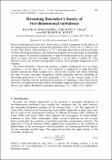Files in this item
Revisiting Batchelor's theory of two-dimensional turbulence
Item metadata
| dc.contributor.author | Dritschel, David Gerard | |
| dc.contributor.author | Tran, Chuong Van | |
| dc.contributor.author | Scott, Richard Kirkness | |
| dc.date.accessioned | 2010-11-29T17:09:21Z | |
| dc.date.available | 2010-11-29T17:09:21Z | |
| dc.date.issued | 2007-11-25 | |
| dc.identifier | 397186 | |
| dc.identifier | d99be448-835f-4bc0-9f6f-104f290bc772 | |
| dc.identifier | 000251474500015 | |
| dc.identifier | 40449132762 | |
| dc.identifier.citation | Dritschel , D G , Tran , C V & Scott , R K 2007 , ' Revisiting Batchelor's theory of two-dimensional turbulence ' , Journal of Fluid Mechanics , vol. 591 , pp. 379-391 . https://doi.org/10.1017/S0022112007008427 | en |
| dc.identifier.issn | 0022-1120 | |
| dc.identifier.other | ORCID: /0000-0001-5624-5128/work/55378698 | |
| dc.identifier.other | ORCID: /0000-0002-1790-8280/work/61133267 | |
| dc.identifier.other | ORCID: /0000-0001-6489-3395/work/64697745 | |
| dc.identifier.uri | https://hdl.handle.net/10023/1494 | |
| dc.description.abstract | Recent mathematical results have shown that a central assumption in the theory of two-dimensional turbulence proposed by Batchelor (Phys. Fluids, vol. 12, 1969, p. 233) is false. That theory, which predicts a X-2/3 k(-1) enstrophy spectrum in the inertial range of freely-decaying turbulence, and which has evidently been successful in describing certain aspects of numerical simulations at high Reynolds numbers Re, assumes that there is a finite, non-zero enstrophy dissipation X in the limit of infinite Re. This, however, is not true for flows having finite vorticity. The enstrophy dissipation in fact vanishes. We revisit Batchelor's theory and propose a simple modification of it to ensure vanishing X in the limit Re -> infinity. Our proposal is supported by high Reynolds number simulations which confirm that X decays like 1/ln Re, and which, following the time of peak enstrophy dissipation, exhibit enstrophy spectra containing an increasing proportion of the total enstrophy (omega(2))/2 in the inertial range as Re increases. Together with the mathematical analysis of vanishing X, these observations motivate a straightforward and, indeed, alarmingly simple modification of Batchelor's theory: just replace Batchelor's enstrophy spectrum X(2/3)k(-1) with (omega(2))k(-1)(In Re)(-1). | |
| dc.format.extent | 13 | |
| dc.format.extent | 669782 | |
| dc.language.iso | eng | |
| dc.relation.ispartof | Journal of Fluid Mechanics | en |
| dc.subject | Dimensional decaying turbulence | en |
| dc.subject | Euler equations | en |
| dc.subject | Enstrophy dissipation | en |
| dc.subject | Contour dynamics | en |
| dc.subject | Self-similarity | en |
| dc.subject | High-resolution | en |
| dc.subject | Energy | en |
| dc.subject | Limit | en |
| dc.subject | QA Mathematics | en |
| dc.subject.lcc | QA | en |
| dc.title | Revisiting Batchelor's theory of two-dimensional turbulence | en |
| dc.type | Journal article | en |
| dc.contributor.institution | University of St Andrews. Applied Mathematics | en |
| dc.identifier.doi | https://doi.org/10.1017/S0022112007008427 | |
| dc.description.status | Peer reviewed | en |
| dc.identifier.url | http://www.scopus.com/inward/record.url?scp=40449132762&partnerID=8YFLogxK | en |
This item appears in the following Collection(s)
Items in the St Andrews Research Repository are protected by copyright, with all rights reserved, unless otherwise indicated.

